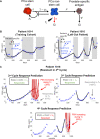A survey of open questions in adaptive therapy: Bridging mathematics and clinical translation
- PMID: 36952376
- PMCID: PMC10036119
- DOI: 10.7554/eLife.84263
A survey of open questions in adaptive therapy: Bridging mathematics and clinical translation
Abstract
Adaptive therapy is a dynamic cancer treatment protocol that updates (or 'adapts') treatment decisions in anticipation of evolving tumor dynamics. This broad term encompasses many possible dynamic treatment protocols of patient-specific dose modulation or dose timing. Adaptive therapy maintains high levels of tumor burden to benefit from the competitive suppression of treatment-sensitive subpopulations on treatment-resistant subpopulations. This evolution-based approach to cancer treatment has been integrated into several ongoing or planned clinical trials, including treatment of metastatic castrate resistant prostate cancer, ovarian cancer, and BRAF-mutant melanoma. In the previous few decades, experimental and clinical investigation of adaptive therapy has progressed synergistically with mathematical and computational modeling. In this work, we discuss 11 open questions in cancer adaptive therapy mathematical modeling. The questions are split into three sections: (1) integrating the appropriate components into mathematical models (2) design and validation of dosing protocols, and (3) challenges and opportunities in clinical translation.
Keywords: adaptive therapy; cancer biology; cancer evolution & evolution; drug resistance; mathematical modeling; medicine; predictive modeling.
© 2023, West et al.
Conflict of interest statement
JW, FA, JG, MS, RB, JB, MR, EK, RN, YV, DB, AA No competing interests declared
Figures




Similar articles
-
Deriving Optimal Treatment Timing for Adaptive Therapy: Matching the Model to the Tumor Dynamics.medRxiv [Preprint]. 2025 Apr 3:2025.04.01.25325056. doi: 10.1101/2025.04.01.25325056. medRxiv. 2025. PMID: 40236415 Free PMC article. Preprint.
-
Predicting patient-specific response to adaptive therapy in metastatic castration-resistant prostate cancer using prostate-specific antigen dynamics.Neoplasia. 2021 Sep;23(9):851-858. doi: 10.1016/j.neo.2021.06.013. Epub 2021 Jul 20. Neoplasia. 2021. PMID: 34298234 Free PMC article. Clinical Trial.
-
The 2019 mathematical oncology roadmap.Phys Biol. 2019 Jun 19;16(4):041005. doi: 10.1088/1478-3975/ab1a09. Phys Biol. 2019. PMID: 30991381 Free PMC article. Review.
-
Mathematical Model-Driven Deep Learning Enables Personalized Adaptive Therapy.Cancer Res. 2024 Jun 4;84(11):1929-1941. doi: 10.1158/0008-5472.CAN-23-2040. Cancer Res. 2024. PMID: 38569183 Free PMC article.
-
Metastatic Hormone-Sensitive Prostate Cancer: Toward an Era of Adaptive and Personalized Treatment.Am Soc Clin Oncol Educ Book. 2023 May;43:e390166. doi: 10.1200/EDBK_390166. Am Soc Clin Oncol Educ Book. 2023. PMID: 37220335 Review.
Cited by
-
Defeating lethal cancer: Interrupting the ecologic and evolutionary basis of death from malignancy.CA Cancer J Clin. 2025 May-Jun;75(3):183-202. doi: 10.3322/caac.70000. Epub 2025 Mar 9. CA Cancer J Clin. 2025. PMID: 40057846 Free PMC article. Review.
-
Practical Understanding of Cancer Model Identifiability in Clinical Applications.Life (Basel). 2023 Feb 1;13(2):410. doi: 10.3390/life13020410. Life (Basel). 2023. PMID: 36836767 Free PMC article.
-
A mathematical framework for comparison of intermittent versus continuous adaptive chemotherapy dosing in cancer.NPJ Syst Biol Appl. 2024 Nov 29;10(1):140. doi: 10.1038/s41540-024-00461-2. NPJ Syst Biol Appl. 2024. PMID: 39614108 Free PMC article.
-
A data assimilation framework for predicting the spatiotemporal response of high-grade gliomas to chemoradiation.BMC Cancer. 2025 Jul 29;25(1):1239. doi: 10.1186/s12885-025-14557-3. BMC Cancer. 2025. PMID: 40730976 Free PMC article.
-
The effect of tumor composition on the success of adaptive therapy: The case of metastatic Castrate-Resistant Prostate Cancer.PLoS One. 2024 Sep 26;19(9):e0308173. doi: 10.1371/journal.pone.0308173. eCollection 2024. PLoS One. 2024. PMID: 39325718 Free PMC article.
References
-
- Acar A, Nichol D, Fernandez-Mateos J, Cresswell GD, Barozzi I, Hong SP, Trahearn N, Spiteri I, Stubbs M, Burke R, Stewart A, Caravagna G, Werner B, Vlachogiannis G, Maley CC, Magnani L, Valeri N, Banerji U, Sottoriva A. Exploiting evolutionary steering to induce collateral drug sensitivity in cancer. Nature Communications. 2020;11:1–14. doi: 10.1038/s41467-020-15596-z. - DOI - PMC - PubMed
-
- Algazi AP, Othus M, Daud AI, Lo RS, Mehnert JM, Truong TG, Conry R, Kendra K, Doolittle GC, Clark JI, Messino MJ, Moore DF, Lao C, Faller BA, Govindarajan R, Harker-Murray A, Dreisbach L, Moon J, Grossmann KF, Ribas A. Continuous versus intermittent BRAF and MEK inhibition in patients with BRAF-mutated melanoma: a randomized phase 2 trial. Nature Medicine. 2020;26:1564–1568. doi: 10.1038/s41591-020-1060-8. - DOI - PMC - PubMed
-
- Baez J, Kuang Y. Mathematical models of androgen resistance in prostate cancer patients under intermittent androgen suppression therapy. Applied Sciences. 2016;6:352. doi: 10.3390/app6110352. - DOI
Publication types
MeSH terms
Grants and funding
LinkOut - more resources
Full Text Sources
Medical
Research Materials

